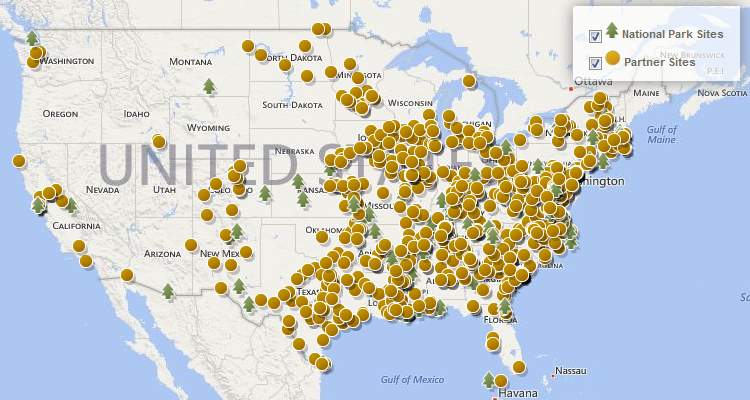America’s historic and natural landmarks may not be as ancient as those found in other parts of the world, but their more recent origins add a tangible quality that may inspire a child’s learning. Whether seeing firsthand the documents our nation was built on, or gazing in awe at the beauty found in our national parks, visits to these places are an opportunity for memorable family bonding and can bring history to life for a powerful learning experience. This series includes tips and educational resources for visiting some of the most amazing landmarks our country has to offer with your kids. Some may be in your back yard, while others require a longer trip, but all are well worth a visit.
Civil War Battlefields
The American Civil War was one of the most trying times in our county’s history. Political unrest in the country and the election of Abraham Lincoln, who pledged to prohibit slavery in new territories, led to 7 of the then 34 states declaring independence from the United States. These states, which largely depended on slavery for their economy, made up the Confederacy. When the Confederate army opened fire on federal troops to secure Fort Sumter in South Carolina, President Lincoln took steps to “suppress the insurrection.” This led to four more states joining the Confederacy and is considered the beginning of the Civil War. Slavery was abolished during Lincoln’s second term. The war lasted four years from 1861 until 1865 and pitted states, countrymen, and families against each other.
This was certainly a tragic time for the United States, and no other war since has been more costly in terms of lives lost. The war also defined the nation. After the war, America entered what is known as the Reconstruction Era. It involved not only the reconstruction of infrastructure after the destructive war, but also that of a people and a government. As Abraham Lincoln said in his Gettysburg Address, America would be brought into a “new birth of freedom” with the end of slavery.
More articles on Slavery
Learning about this period is a critical piece in U.S. history and, fortunately, there are plenty of opportunities to do so. There are more than 1,400 monuments dedicated to the men and women who served during the Civil War and the National Park Service has a database cataloging them all.
While most of the country is familiar with the more popular battles that took place in Gettysburg, Atlanta, and Fort Sumter, many are unaware that battles took place in 25 states going as far west as New Mexico. Aside from battlefields, there were also forts and are monuments dedicated to the men and women in almost every state, including Hawaii.

Civil War Activities
- Civil War reenactments are very popular. If you are planning a trip to see a battlefield, be sure to check both local and national event calendars for a chance to relive history.
- Educational Civil War Movies.
- PBS has a list of free activities and lesson plans available for download.
- The popular YouTube channel Crash Course featuring John Green, which we have featured several times, covers the Civil War in a two part series.
- Check Pinterest for some Civil War Craft ideas.
- Here are more websites with activities for kids.
Suggested Reading
K–3
Two brothers go to a Civil War museum, where they find a door that allows them to travel to real life Antietam.
Elementary School
Follows three girls with three distinct backgrounds. A Union girl unaccustomed to hard living or the war, a Confederate girl willing to disguise herself as a boy to join the fight, and a freed slave girl faced with the decision to flee.
Middle School
This fictional book follows the Western Campaign of the war and tells a story from both the Union and Confederate side.
High Schools
Gone with the Wind which is included on K12’s high school Reading Lists
A story that follows a family living in Georgia near the end of the Civil War and into the Reconstruction Era. The story mirrors what many families had to go through in the South post-Civil War.
Discussion Questions
Below are some questions to think about before you visit a battlefield:
- Why did the soldiers fight in those particular battlefield locations (better ground, fort, important road/railway)?
- Who won the battle?
- How did they win? Did they have have some kind of advantage, or did they have a superior strategy?
- What did the outcome of the battle determine?
- If the other side had won, how would that have changed the outcome of the war?
- Did any important figures die in this battle?
- Did any important figures make a name for themselves or perform a heroic act in this battle?
- If the South had won the war, the country could very well have separated in two different countries.
- Can you think of how your life would be different today if the South had won?
Fun Facts
- Check out the tips section on K12’s Foursquare account for ideas.
- When Lincoln was first elected, he only opposed the expansion of slavery into northern states.
- The Civil War was the deadliest war in U.S. history as causalities from both sides numbered over 600,000.
- You may have heard that equestrian or horse statues have symbolism: If their rider died in battle the horse would have a certain number of legs in the air, indicating how their rider died. This however is not true and is only a myth.
- However! There are six equestrian statues at the battle of Gettysburg and these do (roughly) fit the myth.
- Roughly 30 Civil War veterans are buried at America’s oldest public graveyard.
- The Union Army enlisted African American and Native American soldiers.
- The Union had overwhelmingly greater resources: people, money, infrastructure, weapons, and horses.
- This was the first war that photographs are regularly available, and many events were recorded on film.
- Many of these were taken by the famous photographer Mathew Brady.
- Here are more facts from KidsKonnect.
- The North was led by Ulysses S. Grant who later became the 18th President of the United States.
- The South was led by Robert E. Lee.
- General Lee signed the the surrender at Appomattox Court House on April 9, 1865.
- Lincoln was assassinated just five days after General Lee surrendered.
Featured Image – Ron Cogswell / CC by 2.0






















































































































